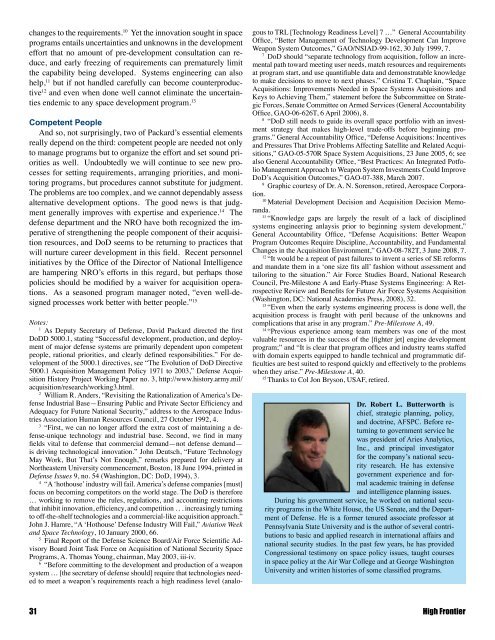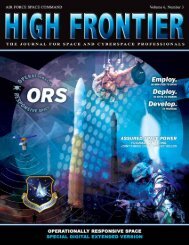Space Acquisition - Air Force Space Command
Space Acquisition - Air Force Space Command
Space Acquisition - Air Force Space Command
Create successful ePaper yourself
Turn your PDF publications into a flip-book with our unique Google optimized e-Paper software.
changes to the requirements. 10 Yet the innovation sought in space<br />
programs entails uncertainties and unknowns in the development<br />
effort that no amount of pre-development consultation can reduce,<br />
and early freezing of requirements can prematurely limit<br />
the capability being developed. Systems engineering can also<br />
help, 11 but if not handled carefully can become counterproductive<br />
12 and even when done well cannot eliminate the uncertainties<br />
endemic to any space development program. 13<br />
Competent People<br />
And so, not surprisingly, two of Packard’s essential elements<br />
really depend on the third: competent people are needed not only<br />
to manage programs but to organize the effort and set sound priorities<br />
as well. Undoubtedly we will continue to see new processes<br />
for setting requirements, arranging priorities, and monitoring<br />
programs, but procedures cannot substitute for judgment.<br />
The problems are too complex, and we cannot dependably assess<br />
alternative development options. The good news is that judgment<br />
generally improves with expertise and experience. 14 The<br />
defense department and the NRO have both recognized the imperative<br />
of strengthening the people component of their acquisition<br />
resources, and DoD seems to be returning to practices that<br />
will nurture career development in this field. Recent personnel<br />
initiatives by the Office of the Director of National Intelligence<br />
are hampering NRO’s efforts in this regard, but perhaps those<br />
policies should be modified by a waiver for acquisition operations.<br />
As a seasoned program manager noted, “even well-designed<br />
processes work better with better people.” 15<br />
Notes:<br />
1<br />
As Deputy Secretary of Defense, David Packard directed the first<br />
DoDD 5000.1, stating “Successful development, production, and deployment<br />
of major defense systems are primarily dependent upon competent<br />
people, rational priorities, and clearly defined responsibilities.” For development<br />
of the 5000.1 directives, see “The Evolution of DoD Directive<br />
5000.1 <strong>Acquisition</strong> Management Policy 1971 to 2003,” Defense <strong>Acquisition</strong><br />
History Project Working Paper no. 3, http://www.history.army.mil/<br />
acquisition/research/working3.html.<br />
2<br />
William R. Anders, “Revisiting the Rationalization of America’s Defense<br />
Industrial Base—Ensuring Public and Private Sector Efficiency and<br />
Adequacy for Future National Security,” address to the Aerospace Industries<br />
Association Human Resources Council, 27 October 1992, 4.<br />
3<br />
“First, we can no longer afford the extra cost of maintaining a defense-unique<br />
technology and industrial base. Second, we find in many<br />
fields vital to defense that commercial demand—not defense demand—<br />
is driving technological innovation.” John Deutsch, “Future Technology<br />
May Work, But That’s Not Enough,” remarks prepared for delivery at<br />
Northeastern University commencement, Boston, 18 June 1994, printed in<br />
Defense Issues 9, no. 54 (Washington, DC: DoD, 1994), 3.<br />
4<br />
“A ‘hothouse’ industry will fail. America’s defense companies [must]<br />
focus on becoming competitors on the world stage. The DoD is therefore<br />
… working to remove the rules, regulations, and accounting restrictions<br />
that inhibit innovation, efficiency, and competition . . . increasingly turning<br />
to off-the-shelf technologies and a commercial-like acquisition approach.”<br />
John J. Hamre, “A ‘Hothouse’ Defense Industry Will Fail,” Aviation Week<br />
and <strong>Space</strong> Technology, 10 January 2000, 66.<br />
5<br />
Final Report of the Defense Science Board/<strong>Air</strong> <strong>Force</strong> Scientific Advisory<br />
Board Joint Task <strong>Force</strong> on <strong>Acquisition</strong> of National Security <strong>Space</strong><br />
Programs, A. Thomas Young, chairman, May 2003, iii-iv.<br />
6<br />
“Before committing to the development and production of a weapon<br />
system … [the secretary of defense should] require that technologies needed<br />
to meet a weapon’s requirements reach a high readiness level (analogous<br />
to TRL [Technology Readiness Level] 7 …” General Accountability<br />
Office, “Better Management of Technology Development Can Improve<br />
Weapon System Outcomes,” GAO/NSIAD-99-162, 30 July 1999, 7.<br />
7<br />
DoD should “separate technology from acquisition, follow an incremental<br />
path toward meeting user needs, match resources and requirements<br />
at program start, and use quantifiable data and demonstratable knowledge<br />
to make decisions to move to next phases.” Cristina T. Chaplain, “<strong>Space</strong><br />
<strong>Acquisition</strong>s: Improvements Needed in <strong>Space</strong> Systems <strong>Acquisition</strong>s and<br />
Keys to Achieving Them,” statement before the Subcommittee on Strategic<br />
<strong>Force</strong>s, Senate Committee on Armed Services (General Accountability<br />
Office, GAO-06-626T, 6 April 2006), 8.<br />
8<br />
“DoD still needs to guide its overall space portfolio with an investment<br />
strategy that makes high-level trade-offs before beginning programs.”<br />
General Accountability Office, “Defense <strong>Acquisition</strong>s: Incentives<br />
and Pressures That Drive Problems Affecting Satellite and Related <strong>Acquisition</strong>s,”<br />
GAO-05-570R <strong>Space</strong> System <strong>Acquisition</strong>s, 23 June 2005, 6; see<br />
also General Accountability Office, “Best Practices: An Integrated Potfolio<br />
Management Approach to Weapon System Investments Could Improve<br />
DoD’s <strong>Acquisition</strong> Outcomes,” GAO-07-388, March 2007.<br />
9<br />
Graphic courtesy of Dr. A. N. Sorenson, retired, Aerospace Corporation.<br />
10<br />
Material Development Decision and <strong>Acquisition</strong> Decision Memoranda.<br />
11<br />
“Knowledge gaps are largely the result of a lack of disciplined<br />
systems engineering anlaysis prior to beginning system development,”<br />
General Accountability Office, “Defense <strong>Acquisition</strong>s: Better Weapon<br />
Program Outcomes Require Discipline, Accountability, and Fundamental<br />
Changes in the <strong>Acquisition</strong> Environment,” GAO-08-782T, 3 June 2008, 7.<br />
12<br />
“It would be a repeat of past failures to invent a series of SE reforms<br />
and mandate them in a ‘one size fits all’ fashion without assessment and<br />
tailoring to the situation.” <strong>Air</strong> <strong>Force</strong> Studies Board, National Research<br />
Council, Pre-Milestone A and Early-Phase Systems Engineering: A Retrospective<br />
Review and Benefits for Future <strong>Air</strong> <strong>Force</strong> Systems <strong>Acquisition</strong><br />
(Washington, DC: National Academies Press, 2008), 32.<br />
13<br />
“Even when the early systems engineering process is done well, the<br />
acquisition process is fraught with peril because of the unknowns and<br />
complications that arise in any program.” Pre-Milestone A, 49.<br />
14<br />
“Previous experience among team members was one of the most<br />
valuable resources in the success of the [fighter jet] engine development<br />
program;” and “It is clear that program offices and industry teams staffed<br />
with domain experts equipped to handle technical and programmatic difficulties<br />
are best suited to respond quickly and effectively to the problems<br />
when they arise.” Pre-Milestone A, 40.<br />
15<br />
Thanks to Col Jon Bryson, USAF, retired.<br />
Dr. Robert L. Butterworth is<br />
chief, strategic planning, policy,<br />
and doctrine, AFSPC. Before returning<br />
to government service he<br />
was president of Aries Analytics,<br />
Inc., and principal investigator<br />
for the company’s national security<br />
research. He has extensive<br />
government experience and formal<br />
academic training in defense<br />
and intelligence planning issues.<br />
During his government service, he worked on national security<br />
programs in the White House, the US Senate, and the Department<br />
of Defense. He is a former tenured associate professor at<br />
Pennsylvania State University and is the author of several contributions<br />
to basic and applied research in international affairs and<br />
national security studies. In the past few years, he has provided<br />
Congressional testimony on space policy issues, taught courses<br />
in space policy at the <strong>Air</strong> War College and at George Washington<br />
University and written histories of some classified programs.<br />
31 High Frontier











